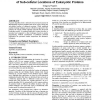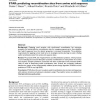243 search results - page 27 / 49 » Application of Evolutionary Algorithms to Protein Folding Pr... |
BMCBI
2010
13 years 8 months ago
2010
Background: Biological processes in cells are carried out by means of protein-protein interactions. Determining whether a pair of proteins interacts by wet-lab experiments is reso...
BMCBI
2006
13 years 8 months ago
2006
Background: Many biological processes involve the physical interaction between protein domains. Understanding these functional associations requires knowledge of the molecular str...
GECCO
2008
Springer
13 years 9 months ago
2008
Springer
A genetic algorithm (GA) is utilised to discover known and novel PROSITE-like sequence templates that can be used to classify the sub-cellular location of eukaryotic proteins. Whi...
BMCBI
2006
13 years 8 months ago
2006
Background: Designing novel proteins with site-directed recombination has enormous prospects. By locating effective recombination sites for swapping sequence parts, the probabilit...
HPDC
2010
IEEE
13 years 9 months ago
2010
IEEE
A common task in biological research is to predict function for proteins by comparing sequences between proteins of known and unknown function. This is often done using pair-wise ...


